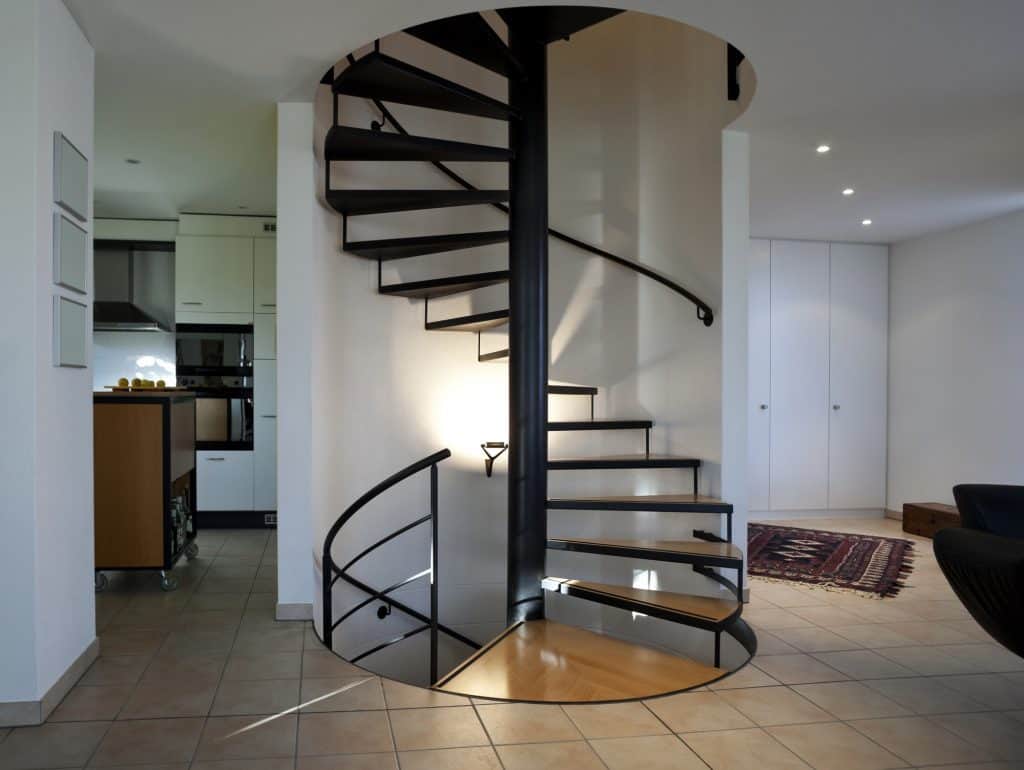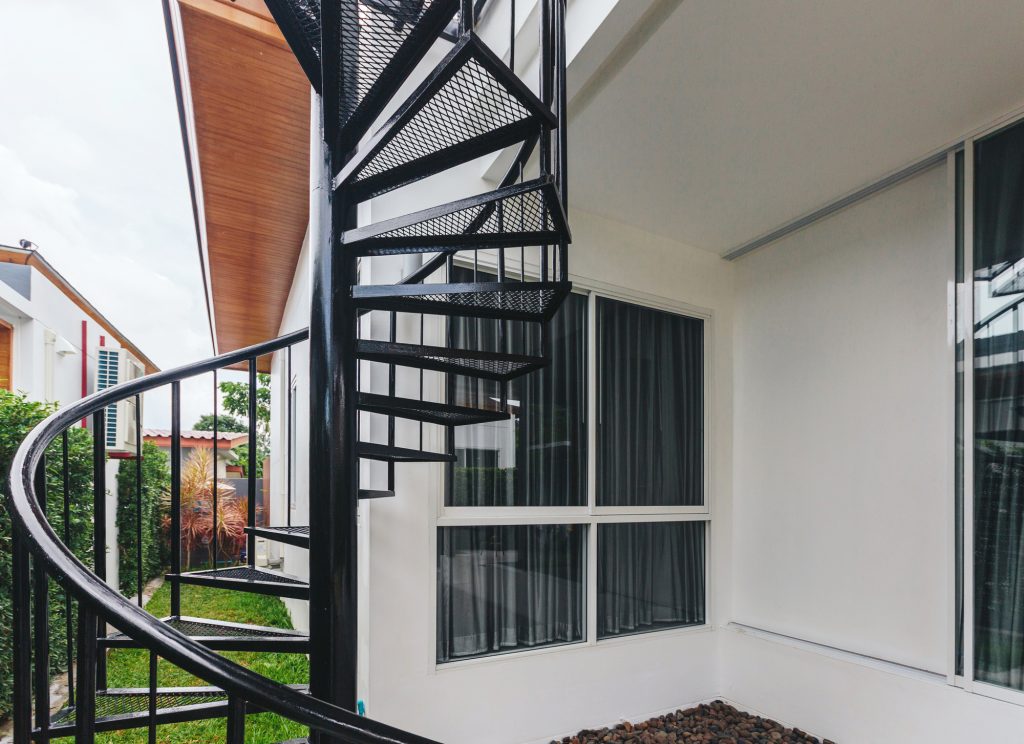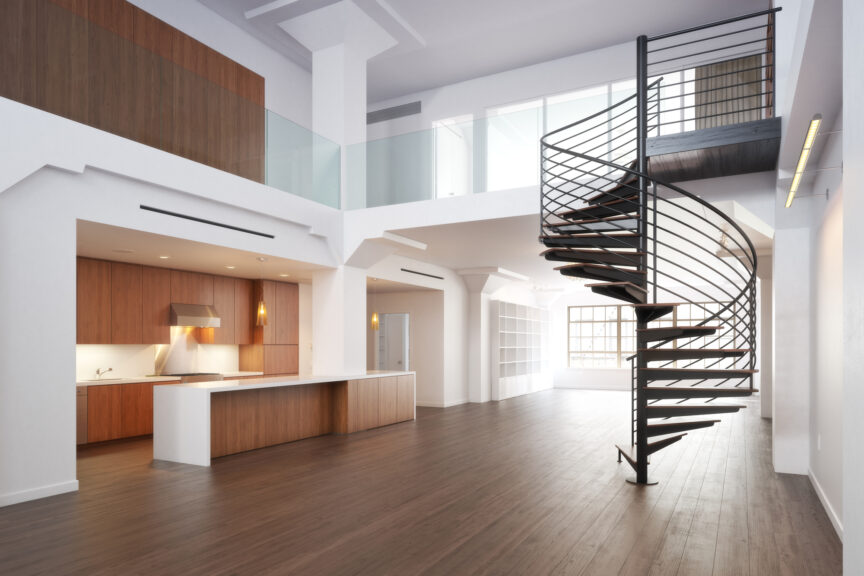Giovanni Valle is a licensed architect and LEED-accredited professional and is certified by the National Council of Architectural Registration Boards (NCARB). He is the author and managing editor of various digital publications, including BuilderSpace, Your Own Architect, and Interiors Place.
Planning for and providing emergency egress is a critical part of building design. One question that often comes up during the design of a home is whether spiral stairs can be included as a means of egress since they are difficult to climb or descend from quickly.
Spiral stairs can be used for egress throughout most of the U.S., but only within a dwelling unit, or from a space not more than 250 square feet (23.25 meters squared) in area and serving not more than five occupants according to the International Residential Code (IRC).
However, it is important that the spiral stair meets all height and width requirements and that the treads of the stair are within the tolerance range allowed by code. Keep reading as we’ll cover some of those requirements in more detail. But first, let’s take a look at what is meant by “egress” from a code perspective.
What is Egress in a House?
Egress is the process of exiting a building, or part of a building, in an emergency. The term typically refers to any means of escape from danger including fire and natural hazards such as floods or earthquakes. As it pertains to buildings, egress can refer to both physical exits and also the path that people take when evacuating a space.
Egress in a house can be provided by either emergency escape and rescue openings, typically doors or windows, or by a circulation path, referred to in the code as a path of egress. This can include a stair or horizontal exit that leads to a safe area of refuge or to the exterior. These elements provide a means of escape in the event of a fire.
Egresses are required by law to be present on every level of your home and may not be obstructed by items such as furniture or toys. The IRC refers to this as a “continuous and unobstructed path of vertical and horizontal egress travel” (R311.1 Means of egress). This path should lead directly to an egress door without requiring travel through a garage.
Are spiral stairs code compliant?
Spiral staircases are generally considered to be safe and code compliant, as long as they meet certain requirements for width and height. They also need to provide protection from slipping and guard rails to prevent falling from the ends. Below is a chart illustrating the minimum or maximum required dimensions for an egress spiral stair.
Dimensional Restrictions for Spiral Stair Used for Egress
| Dimension | Notes | |
| Tread | 7.5 inches (191 mm) minimum | Measured 12 inches from the narrow end of the tread |
| Riser | 9.5 inches (241 mm) maximum | Measured from top tread to top of next tread |
| Clear width | 26 inches (660 mm) minimum | Clear dimension from the post to the face of the handrail |
| Headroom | 78 inches minimum | Measured from top of tread or landing to 3/4 turn of stair |
These requirements apply to spiral stairs that serve as a required exit. For spiral stairs that are not required as a means of egress, the dimensions vary slightly. For example, the tread can measure 5.9 inches (150 mm) minimum as long as it averages 7.9 inches (200 mm) in depth. Likewise, the riser height can be between 7.1 inches (180 mm) and 4.9 inches (125 mm).
In addition to dimensional restrictions, spiral stairs used for egress need to provide other safety features to meet code standards. These include the following:
- Handrails
- Center post
- Non-slip steps
- Balusters at ends
These features further enhance the safety and comfort of the user as they ascend or descend from the stairs. Handrails are typically 1.5 inches (38.1 mm) in diameter and balusters are 1 inch (25.4 mm) square and spaced at a maximum clear distance of 4 inches (101.6 mm).

How are Spiral Stairs Different from Other Stairs?
Spiral staircases are considered alternate stair types, which also include winding stairs and circular stairs. Generally the International Building Code (IBC) does not allow these types of stairs to be used for egress. But as noted previously, an exception is made for spiral staircases when used within private dwelling units.
The primary difference between these types of stairs and standard stairs is their unique shape and circular pattern. They differ from other circular stairs in that they have a center pole that supports the treads and are more compact. The treads vary in size from widest at the ends to most narrow near the post.
Spiral stairs are composed of wedge-shaped treads supported from a central column which usually measures 4 inches in diameter. The outer edge of these stairs has a circular handrail with balusters (horizontal posts) or a combination of balusters with intermediate railings to provide protection from falling through.
Like other stairs, however, the treads must be uniform in terms of height so that each step is within a tolerable limit of 3/16 inches for the riser height between adjacent treads and no more than 3/8 inches variation in height between the largest and smallest riser.
Treads are available in 22.5, 27, and 30 degree tread angles, with the most common being 27 degrees and 30 degrees. This allows them to maintain at least a 7.5 inch dimension at 12 inches from the center pole as required by code. Unlike other stairs, however, the headroom clearance is calculated based on a 3/4 turn rather than measured directly to above.
Below is a useful chart to help you determine the number of treads needed depending on the finish floor height and the turn circumference (i.e., 360 degrees means tread finish directly above). The degree turn refers to where the last tread will end up relative to the starting tread. This is helpful when laying out the stair. The chart assumes a 30-inch tread since it meets code for egress:
30 inch Tread Spiral Stairs: Floor-to-Floor Tread Count
| Finish Floor Height | Number of Treads | Degree Turn |
| 85-95 inches | 9 treads | 270 degrees |
| 96-104 inches | 10 treads | 300 degrees |
| 105-114 inches | 11 treads | 330 degrees |
| 115-123 inches | 12 treads | 360 degrees |
| 124-133 inches | 13 treads | 390 degrees |
| 134-142 inches | 14 treads | 420 degrees |
| 143-152 inches | 15 treads | 450 degrees |
| 153-161 inches | 16 treads | 480 degrees |
| 162-171 inches | 17 treads | 510 degrees |
| 172-180 inches | 18 treads | 540 degrees |
What is the minimum space for a spiral staircase?
One of the biggest benefits of spiral staircases – and the main reason they are used in residences – is that they take up a small amount of space relative to other types of stairs. This is a significant benefit, in particular when working within narrow spaces.
The minimum space required for a spiral staircase will vary depending on whether the stair is used as a means of egress or if it is considered a monumental stair (not used for egress). As noted in the chart above, the steps of a spiral stair used for egress need to be 26 inches (660 mm) in clear width.
This dimension translates to about 5 feet (1524 mm) in diameter once the center post and handrail are factored in. Keep in mind that an additional 2 inches (51 mm) is required on each side for the fingers beyond the diameter of the stair. This increases the total diameter to about 5′-4″ (1532 mm).
Spiral stairs that are not required for egress can be smaller in diameter and still meet code as long as they are not used as an exit stair. They can be manufactured as narrow as 42 inches in diameter (1067 mm), requiring a clear opening of 44 inches (1118 mm) to account for finger spacing.
It should be noted that minimum dimensions are just that. They meet the minimum requirements to comply with the IRC code. For example, while a spiral stair diameter needs to be at least 5 feet in diameter to meet the 26-inch clear code requirement, generally speaking, larger diameters increase perceived comfort, ease of use, and safety.
How to Determine the Opening and Landing
The opening at the top of floor from which you descend down into the stair needs to be a minimum of 44 inches (1118 mm) square to comply with code. As the stair diameter increases, however, the opening needs to be adjusted so that it works with the stair dimension.
To figure out the opening size for a larger stair add 4 inches to the diameter to account for the rail and to avoid a pinch point for the fingers when holding the handrail. The opening for a spiral staircase that is used for egress would therefore need to be 64 inches (1524 mm) square.
The landing of a spiral stair (clear area beyond the final tread) is a function of the tread dimensions. In order to figure out the required landing, divide the diameter of the stair by 2 and add 2 inches. So, a code-compliant egress spiral stair would have a landing that is a minimum of 32 inches (813 mm.)
The table below will help you determine the size of the landing in inches depending on the diameter of the stair:
Landing Size Relative to Stair Diameter
| Diameter | 40″ | 48″ | 52″ | 60″ | 64″ | 72″ | 76″ | 88″ | 96″ |
| Landing Size | 22″ | 26″ | 28″ | 32″ | 34″ | 38″ | 40″ | 46″ | 52″ |
What Materials are Spiral Staircases Usually Made From?
The most common tread and platform materials used in spiral staircases include steel (regular and galvanized), aluminum, and wood. Sometimes the materials are used in combination.
Metals: Metal is a commonly used material for spiral staircases, usually in the form of steel or aluminum. When used for metal treads steel and aluminum can be smooth plate, checker plate, pan type, and bar. Railings and balusters are also commonly made from these materials. Metal stairs lend themselves well to being manufactured.
Wood: A variety of hardwoods can be used, although many manufacturers use steel substructures to support the wood finish surface. Usually, wood is used on the treads of the stair, though it can also be used for balusters and railings.
Concrete: Concrete is often used for treads as it is a fairly abrasive material which can aid in reducing slippage. It can be either used on its own or in combination with steel, as in the case of a metal pan system. Concrete treads are durable and relatively quiet compared to other materials.
Stone: Stone is another material that is sometimes used in stair treads. It can be cut and shaped as desired and pre-manufactured prior to the onsite installation. Marble and granite are the most commonly used stone for stairs. Stone surfaces need to be treated to provide some level of abrasion or traction.
Glass: While less common, glass can also be used in spiral staircases. Glass can be used as a guardrail, either in combination with a metal railing or on it’s own. Glass can even be used for treads (see Apple staircase). When glass is used for treads it is laminated, layered, tempered, and thoroughly tested for strength.

Can a spiral staircase be a fire escape?
The term fire escape usually infers an emergency exit mounted to the exterior of a building. Since the International Building Code (IBC) and IRC specify that spiral stairs are only allowed to be used for egress within a private dwelling unit, they would not be allowed to be used as an exterior stair for fire escape.
That doesn’t mean that spiral staircases are prohibited from exterior use, it just means that they would not be considered a means of egress for emergency escape. It’s important to note that while the IBC and IRC are universally accepted throughout the U.S., there are local building codes in some states that may differ.
Likewise, in addition to building codes, there are other types of codes such as zoning codes that may also restrict the use of exterior stairs. Moreover, some cities have local review boards such as architectural or design review boards which may also have specific requirements or limitations. You should check your local building codes to be sure.
Closing Notes
Spiral staircases offer a good option for spaces that are cramped and require a minimal stair footprint. As long as they are used within dwelling units and meet the minimum or maximum dimensions prescribed by code, they can be used for egress.
Spiral stairs can be either built in place or manufactured and installed. Metal stairs, made of either steel or aluminum are the most suitable for manufacture since they can be easily built and assembled in a factory setting. Often times, stairs can be manufactured from a combination of different materials, such as wood and metal, glass and metal, concrete and steel, etc.
It’s important that spiral stairs adhere to the dimensional restrictions set by code in order to ensure both safety and comfort. Keep in mind, however, that spiral stairs with larger diameters are generally perceived as more comfortable and easier to use, thereby making them safer for the user.
Sources
- International Residential Code (IRC), International Code Council, Inc.
- International Building Code (IBC), International Code Council, Inc.
- The Architect’s Studio Companion, Edward Allen, Joseph Iano
- Architectural Graphic Standards, Ramsey/Sleeper, The American Institute of Architects
Share this Post

